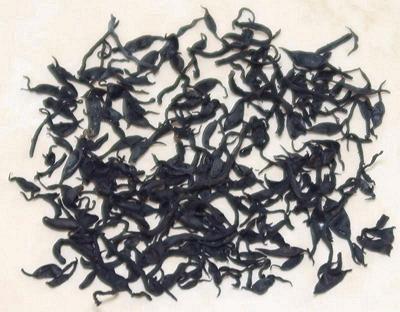 [Hijiki, Hiziki (Japan); Nongmichae (Korea); Hai tso, Chiau tsai,
Hai ti tun, Hai toe din, Hai tsao, Hoi tsou (China);
Sargassum fusiforme]
[Hijiki, Hiziki (Japan); Nongmichae (Korea); Hai tso, Chiau tsai,
Hai ti tun, Hai toe din, Hai tsao, Hoi tsou (China);
Sargassum fusiforme]
This seaweed is found along rocky coasts of China, Korea and Japan, and is now cultivated along the coast of China and the Korean coast facing China. Used as a sea vegetable in Japan, it was brought to North America by the Michio Kushi Macrobiotic movement, and is now fairly common in Japanese restaurants here. It is imported from Japan, China and Korea in dried form, and that is how it is generally used in Japan.
Hijiki is available in two forms, Leaf Form (Mé Hijiki) as shown in the photo, and Wire Form (Naga Hijiki), which looks like a tangle of thin black wires. Either will work fine, but some prefer the Bud Form. Rehydrated and cooked it is said to have a slight anise flavor, but that resemblance is rather faint. It is used in a number of recipes in Japan, and also is ground to impart color and a speckled appearance to Konnyaku Jelly.
More on Algae.
The arsenic content is not likely to be dangerous in the quantities consumed in normal culinary usage, even in Japan, and no adverse effects have been reported. The warnings apply mainly to "health nuts" who tend to overdo "healthy" things until they aren't healthy, and also may apply to the Macrobiotic movement, as members eat unusually high amounts of seaweed, including Hijiki. On the plus side, many studies have brought up significant health benefits from Hijiki extracts, including anti-tumor factors and activity against HIV-1. Research is ongoing.
al_hijikz 221204 - www.clovegarden.com